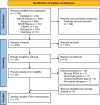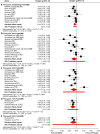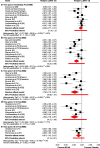Attenuating Muscle Damage Biomarkers and Muscle Soreness After an Exercise-Induced Muscle Damage with Branched-Chain Amino Acid (BCAA) Supplementation: A Systematic Review and Meta-analysis with Meta-regression
- PMID: 38625669
- PMCID: PMC11021390
- DOI: 10.1186/s40798-024-00686-9
Attenuating Muscle Damage Biomarkers and Muscle Soreness After an Exercise-Induced Muscle Damage with Branched-Chain Amino Acid (BCAA) Supplementation: A Systematic Review and Meta-analysis with Meta-regression
Abstract
Background: Branched-chain amino acid (BCAA) supplementation is one of the most popular strategies used by the general population and athletes to reduce muscle soreness and accelerate the recovery process of muscle damage biomarkers after an intense exercise or training session.
Objectives: This systematic review and meta-analysis investigated the effects of BCAA supplementation on muscle damage biomarkers and muscle soreness after exercise-induced muscle damage (EIMD).
Methods: The systematic literature search for randomized controlled trials was conducted using seven databases, up to September 13th, 2022. The eligibility criteria for selecting studies were as follows: studies performed on healthy active participants, using BCAA at least once, controlled with a placebo or control group, performing resistance or endurance exercises, and followed up at least once post-EIMD. The methodological quality of the studies was assessed using the "SIGN RCT checklist". Random-effects meta-analyses were processed to compute the standardized mean difference (Hedges' g). Meta-regression analyses were completed with daily and total dosage and supplementation as continuous moderator variables.
Results: Of the 18 studies included in this meta-analysis, 13 were of high quality and five were of acceptable quality. Our results revealed BCAA supplementation elicits a significant effect on reducing creatine kinase (CK) levels immediately (g = - 0.44; p = 0.006) and 72 h (g = - 0.99; p = 0.002), but not 24 h, 48 h, and 96 h post-EIMD. Additionally, a significant effect on delayed onset of muscle soreness (DOMS) was identified at 24 h (g = - 1.34; p < 0.001), 48 h (g = - 1.75; p < 0.001), 72 h (g = - 1.82; p < 0.001), and 96 h (g = - 0.82; p = 0.008), but not immediately post-EIMD. No significant effect was found on lactate dehydrogenase (LDH) levels at any time point. Meta-regression indicated higher daily and total dosages of BCAA, and longer supplementation periods were related to the largest beneficial effects on CK (total dosage and supplementation period) at 48 h, and on DOMS at 24 h (only daily dosage).
Conclusion: The overall effects of BCAA supplementation could be considered useful for lowering CK and DOMS after EIMD, but not LDH. The longer supplementation period prior to the EIMD could be more effective for CK and DOMS reduction.
Keywords: Branched-chain amino acid; Creatine kinase; Lactate dehydrogenase; Muscle damage; Muscle soreness; Recovery.
© 2024. The Author(s).
Conflict of interest statement
The authors declare that they have no competing interests.
Figures




References
Publication types
LinkOut - more resources
Full Text Sources
Research Materials

